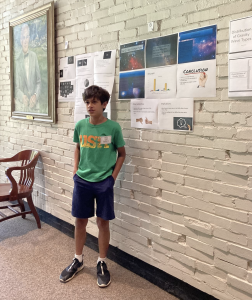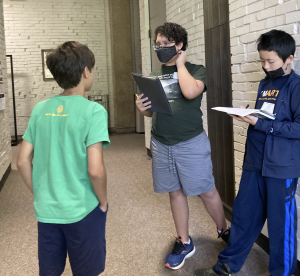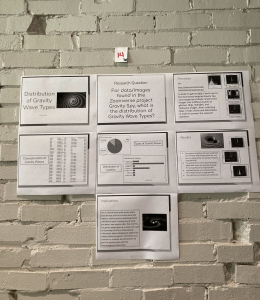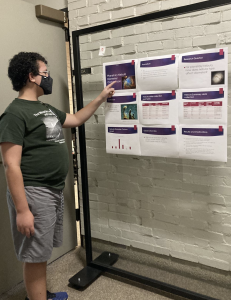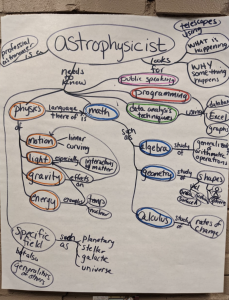Summer SAVY 2022/Session 5 – Stellar Astronomy for Rising 7th/8th Grade
Friday: A great final day of Stellar Astronomy! First and foremost, we had to finish designing the research posters we started yesterday to prepare for our afternoon Poster Session. Most students had to work on “de-wordifying” (i.e. make bullet points, not sentences), some on making good font sizes, some on beautifying, some on making good conclusion statements with numbers included… When a person completed their poster, then they reviewed a peer’s poster using a guiding handout and then improved their poster using that feedback. These are all things that scientists do when preparing to communicate their work so it worked out great.
Some students were able to experiment with the Kepler’s law simulator from a couple of days ago or examine awesome images and movies on the LIGO website (it’s the gravitational wave detector that’s finding black hole and neutron star mergers) and maybe doing a bit of further research (some found some good Kurzgesagt videos). Some also had fun with the Wikipedia game where you start with the “Random Article” on Wikipedia and then somehow get to the article I choose for them – at first it was “Supernova” (a great article!) and second was “Logarithm” – folks enjoyed figuring out how to make the connections and how to “hack” it!
While we were waiting for poster printing (some trial and tribulation there), we had an interlude where we discussed how we are stardust! Here are two very cool science-y songs from the Symphony of Science about it: “We Are All Connected” and“We Are Stardust”. Anyway, the Wikipedia article about nucleosynthesis is awesome as is the SVG of the period table.
Then we talked about light and how astronomers use multiple wavelengths of it to determine information about all kinds of objects (for instance, ultraviolet tells us about hot stars, radio waves tell us about hydrogen, dust, and magnetic fields). Light is pretty much the only information we get from the Universe so we have to know how it works. We discussed the different kinds of light (the electromagnetic spectrum) and what sorts of astronomical objects you can see with the different kinds of light. Students enjoyed looking at multiwavelength observations of galaxies. Some specific images that students liked were of M81 and the Cartwheel Galaxy (other version).
Afternoon brought us the ASTRONOMY POSTER SESSION! Students presented to peers and we instructors for about 3 minutes while in a group with others. This is totally like real life in a professional poster session. Ask your scholar to show you their poster and give you their presentation! While students gave presentations, their peers filled out short evaluation forms to help everyone get the most out of the presentations that they could. All peers asked questions of the people they listened to and it was awesome to see how well our scholars could answer them! Everyone showed confidence and knowledge.
Ask your scholar about any of these things:
- Why did you choose the question you did?
- What was the biggest challenge you had while completing the research/poster?
- How did you feel about your research before, during, and after the actual presentation?
- What kinds of things did you evaluate your peers on, both in the computer lab and when listening to posters?
- What were some of your favorite research topics you saw from others? What about ways of presenting data?
- What might you do differently now that you know more (or saw others or had more time)?
- Did you feel prepared for the project by things that you did during class this week?
All and all, everyone did an impressive job and I’m so excited for their future. Thank you for letting me work with your scholar this week!
-Dr. Grundstrom 🙂
Thursday: Day 4 of Stellar Astronomy started out with some mind-bending action! We did first do a short discussion of true versus false color in imaging, so we compared two images of the Eagle Nebula – near true color and false color (specifically the “Hubble Palette” – and here’s an interesting article about “The Thing with Colors in Astrophotography”). There was much discussion of which was better 😉
On to mind-bending! We moved on to the theory of gravity a.k.a. GENERAL RELATIVITY! First we discussed the three-dimensional nature of spacetime curvature (good images here and here) but how we have to use a two-dimensional version thereof. Then we experimented with different types of orbits using plastic tubs, spheres, and nitrile gloves! Changing the mass of the central object changes the behavior of things around it. We also looked at an animation of a computer simulation of a merging black hole pair.
Various examples of these demonstrations:
– Spandex Gravity Well from U of Toledo
– Operation Spandex from the Society of Physics Students
– Brian Greene Explores General Relativity in His Living Room
We also looked at the evidence for the supermassive black hole at the center of the galaxy (Nobel Prize winner Dr. Andrea Ghez’s group at UCLA looking at stars going around SgrA*) and NASA’s Black Hole Orrery. More evidence for the awesomeness of Newton’s version of Kepler’s third law of orbital motion!
After our break, we had to look at one last thing with spacetime curvature – gravitational lensing! (One-Minute Astronomer article; Wikipedia article) Here are some images of what it looks like: almost-ring, various Einstein rings, multiple images of a background galaxy, lots of galaxy cluster lensing
It happens when there’s something producing light that is behind a massive object – the massive object bends spacetime so bends the straight line light travels on.
Oh, early on, we decided to compare two images of the Eagle Nebula – near true color and false color (specifically the “Hubble Palette” – and here’s an interesting article about “The Thing with Colors in Astrophotography”). There was much discussion of which was better 😉
Finally, these scholars were real scientists today! In preparation for making a poster with an answerable research question, students first explored “Dr. G’s Approved Websites” – each student picked two of the approved ones to examine and then complete some explorative questions. Then students designed an answerable research question, carried out (or are carrying out) the research, working on a conclusion, and are designing a research poster! There’s a wide variety and everyone is excited to see how they turn out when printed.
Ask your scholar
- what makes a good research question and if their first questions they submitted were successful and why/why not
- what websites they decided to explore and what they found interesting or what they struggled with for each
- explore some websites with your students
Wednesday:
Day 3 of Stellar Astronomy was full of cool stuff! As a recap of yesterday’s lab work, we talked about all of the things that MASS determines about stars (and things it doesn’t). Therefore, we had to talk about how astronomers determine mass – it usually involves ORBITS and of course, there’s an equation for it 🙂 To talk about orbits, we had to look at Kepler’s laws of planetary motion: 1) orbits/trajectories are ellipses / conic sections ; 2) orbiters move faster when closer to gravitational source (applet from class and another) ; and the big one, number 3) the period of an orbiter is related to the orbital distance and the masses involved (and used Newton’s version thereof). This super important equation works for ALL things that have orbiters (moons, planets, stars, star clusters, galaxies…). Here’s a fun applet to test out doing some orbiting and some students compared this to the video game Kerbal Space Program that includes “realistic aerodynamic and orbital physics” – recommended for those who love space travel!
In order to more fully understand cosmic recycling and look at how (admittedly beautiful) images show scientific data (but can also be false color), we got to have a bit of a slide show! These images, as I had hoped, really got students thinking and asking questions! First we start with clouds of gas and dust (Statue of Liberty Nebula, Mystic Mountain (in the Carina Nebula), Fox Fur Nebula, Bubble Nebula, Eagle Nebula) that form more and more stars (cluster NGC 2244 in the Rosette Nebula) and then will eventually form star clusters (open cluster: the Pleiades and globular cluster: NGC 6093 (Messier 80)). Once a star cluster is formed, then it may dissipate or it may stay together – we’ll be talking more about that later this week.
One of the favorite things students did today was see light through diffraction gratings!! This is part of SPECTROSCOPY and can help us determine composition, motion, spin rate, stuff about magnetism, binarity, all sorts of awesome stuff!! As I told everyone today – a picture may be worth a thousand words, but a spectrum is worth a thousand pictures 😉 We’ll talk more about it tomorrow. If you’re interested, here are some double-axis (and glasses) and some single-axis ones.
After lunch, we went to the computer lab to engage in some real science and using spreadsheets. First we used the Zooniverse citizen science project aggregator. This site is definitely worth looking at more – there are lots of ways to spend time helping science go further, not just in astronomy. The project we looked at was the SuperWASP Variable Stars project looking at types of stellar variability. With these data, we generated data tables, aggregated partner data, sorted, used “COUNTIF”, and generated pie charts. Then we grabbed a bigger data set about sunspots from the Sunspot Index and Long-term Solar Observations (SILSO) website where we learned about one of the most amazing features that both Excel and GoogleSheets have -> text-to-columns! From that, we protected our original data, sorted, copied, and made scatter plots.
Have your scholar show you what they did!
Finally, the next round of impromptu speaking went really well! It really is impressive to see everyone go for it despite a bit of discomfort.
Tuesday: Day 2 of Stellar Astronomy focused on stellar evolution – through lecture and through lab. To start, we examined the HR diagram from yesterday more thoroughly looking at the odd way that the axes go (higher temperatures on the LEFT!), looking at logarithmic axes to help show very large and very small numbers at the same time, and looking at how the trends shown help us understand stellar populations. Some HR diagrams we used were the one with nearby stars plus bright stars and some from the Hipparcos data set. Make sure to note what all the axis labels are (including logarithmic-ness and colors) and how one can use information from one example graph to one with data points.
I personally enjoyed discussing general stages of stellar evolution and the various remnants one can get (including planetary nebulae and supernova remnants). Ask about what happens when fusion ends! (btw, here’s the link to the proton-proton chain)
After lunch, we really went for it with stars and stellar evolution. After generalizing some stellar information, we further examined the great Wikipedia data table from yesterday with an eye to estimating the percentage of stars that actually do turn into black holes (we’ll discuss more black holes later this week). Eventually we went to a website to start doing some research with stellar evolution!
– Digital Demo Room Stars and Stellar Evolution
– with upgraded videos at Illinois Astrophysical Dynamics Demonstrations
The research questions designed from this can inform how we’ll ask the answerable research questions for the end-of-week research poster.
For those who want it, here’s
– link to the Wikipedia Supernova page
– that image of the 100 planetary nebulae 🙂
We ended the day with impromptu speaking (to help be more comfortable with talking in front of peers in preparation for the posters on Friday). I was very impressed with how our scholars just went for it!! Tomorrow will have another round!
Monday: We had a mind blowing day in Stellar Astronomy today! The students are so excited to learn and ask all of their questions about astronomy!
We started out the day with introductions of each other – it’s great to learn what people have in common and to learn about something new and to practice speaking as all scientists have to be able to communicate their work verbally and in writing. We also designed our Classroom Guidelines – I was impressed with the thoughtfulness of many of the students regarding what makes a great classroom. There was also much thoughtfulness in the strategies to overcome frustration or being “stuck” – we have some great lists! Given that this is Career Connections, we discussed what an astrophysicist needs to know – it’s fascinating learning WHY one takes certain classes (see attached image).
Students were very excited to start learning about stars themselves and really enjoyed our Orion image and the star cluster M25 and then about the colors of stars. In general, when one looks at an image of stars, one sees colors and color of a star = temperature of the star! The symbol used for temperature wasn’t Fahrenheit or Celsius, scientists use Kelvin!
Then we started examining a data table about stellar classification (found on Wikipedia). In order to fully understand our data table, we looked at various trends with temperature and then we started talking about the symbols one can see (we sidetracked a bit to astronomical symbols).
Perhaps the most mind-blowing topic of today was scientific notation! As the numbers in astronomy are generally huge, we have to use a different way to write them or it’s just too cumbersome. For instance, the Sun’s mass is 2 nonillion kilograms (check out Wikipedia’s Names of Large Numbers list). We practiced and did a little bit of arithmetic with the exponents. During our discussion, students were very interested in terms I used like “light years” and the size of our galaxy – 200,000 light year diameter as well as the unit “parsec” (EarthSky article; Wikipedia article).
We also discussed how you write out ones work and answers to problems in a professional way. This stemmed from discussions of the equation for luminosity and the equation for magnitudes and distances. We’ll put it more into practice during the next few days.
During the middle of the day, students got to see one of the most important diagrams in all of astronomy – the Hertzprung-Russell diagram. We discussed things they recognized and things they found interesting – it’s a great springboard for more discussion.
Now that we know about all of these things, we can really start looking at and understanding stellar data and graphs! Tomorrow we look at gravity, orbits, and stellar evolution! Tomorrow we’ll also continue our “impromptu speaking” activities!
